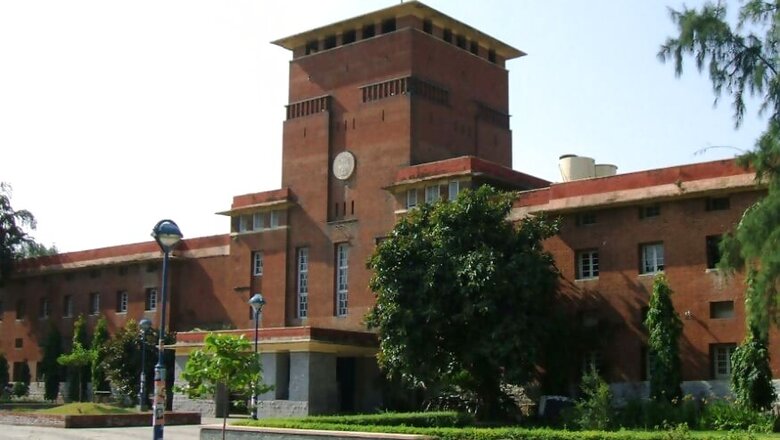
views
In about a week’s time, keenly contested elections to the Delhi University Students Union (DUSU) would be held. The direct elections to the students’ body started in the 1970s, sometime before the Emergency, and have largely witnessed keen contest between Congress-affiliated National Students Union of India (NSUI) and the RSS-sponsored Akhil Bharatiya Vidyarthi Parishad (ABVP).
There have been times when some other political forces have entered the fray and had some impact, but then those have been more or less cases of aberration than any trend. This time around, too, the students’ arm of the Aam Aadmi Party (AAP), Chatra Yuva Sangharsh Samiti (CYSS), has entered the fray after a gap, albeit in alliance with the All India Students Association (AISA).
This is not the first time that AAP-sponsored CYSS has entered the polls. Soon after the party’s victory in 2015 assembly elections, they had independently contested all the four DUSU seats and, to the embarrassment of the party leadership, their efforts had come a cropper. During those polls, the AAP MLAs, ministers and office bearers had participated in the polls in a big way.
Learning from experience, this year they are trying their luck in association with the only formidable Left-wing force on the campus, the AISA. This is being done with next year’s Lok Sabha elections in mind as the AAP hopes to retain its identity as a recognizable political force.
This alliance, however, presents an oxymoronic combination as the AAP in its present ‘avtar’ preaches and practises a genre of politics which the AISA has protested against all these years. Maybe the needs of politics and the desire to remain relevant has spurred this alliance for, what has become in recent years, a caste-based election.
The nearly century-old university, in fact, draws contrasting images when admissions happen and when elections take place, with a time gap of just two months. In an ideal world, universities should be port-keys for bridging social divides. They should not be instruments for widening existing chasms. Unfortunately, the DUSU polls has come to perpetuate the latter.
The metamorphosis of DUSU elections from being a contest between ideologies to a wrestling match of caste combinations is the butterfly effect of the admission quota introduced in Delhi University for applicants from the Other Backward Classes (OBCs) during the UPA-I regime by then HRD minister Arjun Singh.
Though Arjun Singh’s formula managed to retain the existing number of seats for the General category students, it did so by providing for extra seats to accommodate the increased number of OBC students. While doing his bit for the ‘benefit’ of the student community from all castes, little did Arjun Singh realise that he was going to create faultlines inside every classroom.
Today, while students with 90% marks from the General category finds it difficult to get a toehold in a respectable course of a reasonable college of the university, those with a much lesser percentage get through. What has worsened the situation is the failure of the Delhi University administration in implementing the creamy layer criterion for the OBC students with any rigour.
This has created a situation where ‘poorer’ candidates from the OBC categories have been denied admission under the quota as the moneyed have grabbed the seats. Ironically, Delhi’s applicants from economic elite from urban villages belonging to the Gujjar and Jat communities have been getting easy entry, whereas students from weaker castes and economically weaker homes have not got the benefit.
These candidates from the creamy layer communities use their admissions tickets first to contest Delhi University polls and then flaunt their success in students’ politics for political positions at a higher level.
A close study of the poll trends of the past few years would show that the polling percentage has not moved beyond 45 percent. This trend is reflective of the lack of participation by the more serious students in the poll process.
It would be worthwhile for the Delhi University administration to find out the academic profile of the voters, and I am certain they would largely be from the quota categories. The proof of this is in the selection of candidates, be it the one affiliated with the Rashtriya Swayamsewak Sangh (RSS), the Congress or the Aam Aadmi Party (AAP).
Given the profile of the candidates and changing morphology of the poll process, money is increasingly playing a big role. The financial sinews of those seeking tickets have become major factor in deciding candidature. It goes without saying that this is very unfortunate situation and has defeated the very purpose of allowing politics on the campus.
I recall a former Delhi University teacher, who spent a lifetime conducting students’ union elections, once writing on social media that “there is an urgent need to abolish students unions as now they have become a vehicle to perpetuate hooliganism and corruption and criminalisation in Indian politics. I do not think developed nations have this concept in their colleges. There should be a national debate on it.”
The Lyngdoh Committee, which was appointed by the Supreme Court, in its guidelines says, “The maximum permitted expenditure per candidate shall be Rs 5,000. With the view to prevent the inflow of funds from political parties into the student election process, the candidates are specially barred from utilising funds from any other sources than voluntary contributions from the student body.”
The ‘tamashas’ being put-up on Delhi University campus this week would run a bill into several crores of rupees. Besides the use of money and muscle, what should be of greater concern is for those who have been through the portals of Delhi University is the social divide that these polls have increasingly come to reflect. One wonders if anybody is listening!
(The writer is a senior journalist and political commentator. Views are personal)




















Comments
0 comment